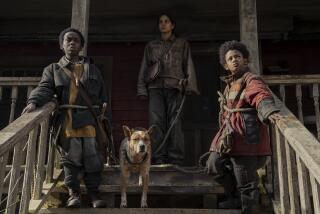MOVIE REVIEW : Logic Lapses in ‘Hellbound: Hellraiser II’
- Share via
Oh, there’s no place like hell for the holidays.
Certainly there’s almost as much gleeful perversity evident in the decision to open “Hellbound: Hellraiser II” (citywide) on Christmas weekend as there is in the film itself, a bubbling, bloody sore of a sequel. This follow-up is faster and campier than its mostly somber predecessor, but the basic grim tenets of British horror author Clive Barker’s supernatural worldview are still intact: a universe with a senseless hell but no heaven, without a god but with plenty of demons, without real good but oozing evil to spare. Ho ho ho.
No, that’s not Jimmy Stewart’s angel Clarence floating this way. It’s those nasty Cenobites, gruesome genies who wear black robes and look like pus-faced rejects from a “Dune” casting call, arriving from hell on cue to inflict unspeakable pleasure and pain (mostly the latter) every time another hapless soul solves a mysterious puzzle box.
The original 1987 “Hellraiser” offered only the vaguest implications of what kind of delights and agonies the Cenobites offered on the other side. It remained earthbound--due in part, no doubt, to budgetary constrictions--but also to writer-director Barker’s getting more of a kick out of the mortal sex and violence the Cenobites set in motion than in the actual details of their supernatural plot machinations.
“Hellbound: Hellraiser II,” though, aims to go all the way and give us a guided tour of hell, which turns out to be as much funhouse as inferno. (We’ll burn and we’ll play, the Cenobite way, walkin’ in a Dante wonderland . . . ) Barker is on board only as executive producer this time, and his unsettling presence is missed amid all the fun and frolic that goes on in this thrill-a-second underworld, so full of mazes and mirrors.
Where “Hellraiser” was creepily and traditionally Gothic, “Hellbound,” the work of first-time director and former optical-effects man Tony Randel, is a no-holds-barred plunge into Spielbergland. The dread of the first film has been traded in for more monsters; it’s less Poe than it is “Poltergeist II,” more “Lost Ark” than Lovecraft.
The story picks up immediately after the climax of the first film: We join teen-age Kirsty (Ashley Laurence) in a psychiatric ward, where she was left sedated shortly after she came across her father’s skinned carcass, witnessed the stabbing death of her evil stepmother and fought off her lecherous zombie uncle. (Innards-filled flashbacks aplenty.)
Naturally, none who hear Kirsty’s story are willing to believe it, except, that is, for the preternaturally calm Dr. Channard (Kenneth Cranham), a closet hedonist and secret puzzle-box collector who immediately recognizes the girl’s tall tale to be true.
Before long the bad doctor has figured out how to resurrect Kirsty’s sexy, skinless stepmom (Clare Higgins), and has employed another of his psychiatric charges, an apparently autistic girl (Imogen Boorman), to solve the puzzles and send all four of them, wicked and innocent alike, on a trip to the tropics.
The episodic shenanigans that ensue for the quartet in this other world bear more resemblance to set pieces from the “Elm Street” and “Poltergeist” series--or the superior “Dreamscape”--than the subtler product of Barker’s disturbed imagination. It’s more of an action/adventure picture this time around, if still an exceptionally grisly one, and hardcore Barker enthusiasts may bemoan the switch in tone even as a wider popular audience is brought in.
Genre buffs may also have a hard time overlooking the lapses in logic that proliferate in “Hellbound: Hellraiser II” (MPAA-rated R for considerable bizarre violence). How can someone who’s already a confirmed denizen of hell be killed again, as a number of the Cenobites are? Is this some kind of gag, the underworld version of being “born again,” or, more likely, just screenwriter Peter Atkins forgetting to use his noggin? Season’s bleedings.
‘HELLBOUND:HELLRAISER II’
A New World Pictures presentation. Producer Christopher Figg. Executive producer Clive Barker. Director Tony Randel. Associate producer David Barron. Script Peter Atkins. Camera Robin Vigeon. Editor Richard Marden. Music Christopher Young. With Clare Higgins, Ashley Laurence, Kenneth Cranham, Imogen Boorman, William Hope, Doug Bradley.
More to Read
Only good movies
Get the Indie Focus newsletter, Mark Olsen's weekly guide to the world of cinema.
You may occasionally receive promotional content from the Los Angeles Times.










